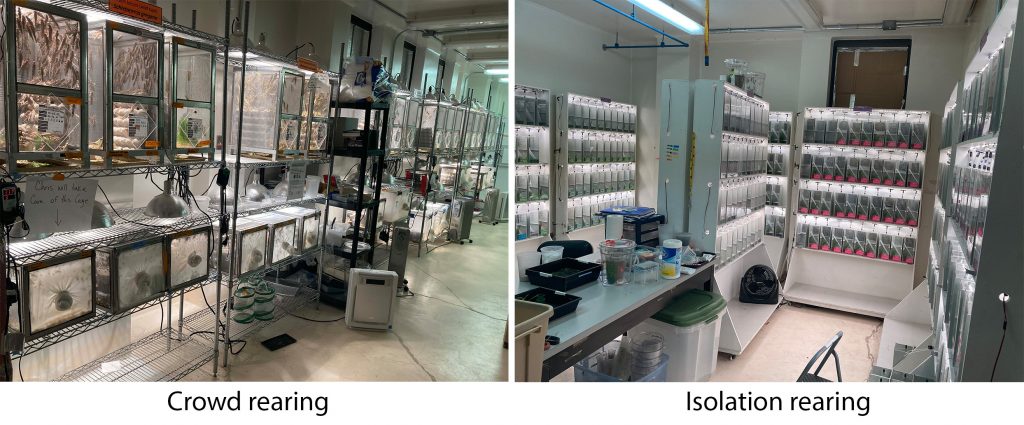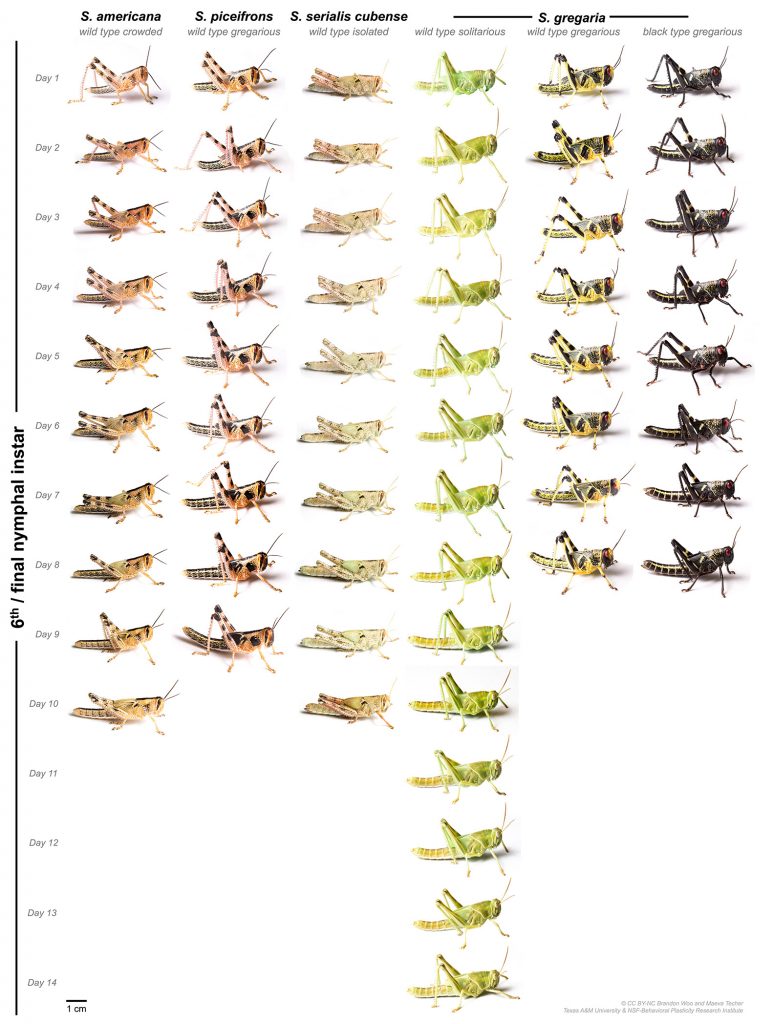Locust Rearing Facility @ TAMU
As part of the BRPI, we have developed a large rearing facility that can house all six Schistocerca species (three locust species: S. gregaria, S. piceifrons, S. cancellata; three non-swarming species: S. americana, S. serialis cubense, S. nitens) and has the capacity to rear the insects in crowded and isolated conditions to induce density-dependent phenotypes. Located in a USDA-approved quarantine facility (Containment Facility 1250) within the Biological Control Facility in the Department of Entomology at Texas A&M University, this 1,600 ft2 facility includes a dedicated large room for rearing locusts in high density, containing custom-designed cages of various sizes. It also has a dedicated isolation room which has the capacity to rear up to 360 isolated locusts singly in small individual cages (custom-designed using injection molding) that can completely isolate the test subjects visually, physically, and chemically. The rearing facility also contains a dedicated room for behavioral assays for individuals and collective movement, as well as a temperature-controlled environmental chamber for physiological studies. This facility is the only one in the world that is dedicated to rearing multiple Schistocerca species. Currently, the facility maintains colonies of the desert locust S. gregaria (wildtype, originally from Mauritania, sourced from the University of Leicester, U.K), black S. gregaria (mutant line sourced from the University of Leicester), the Central American locust S. piceifrons (wildtype, originally from Yucatan), S. americana (wildtype, originally from Florida), and S. serialis cubense (wildtype, originally from the Florida Keys). We expect to receive a seed colony of the South American locust S. cancellata (wildtype, originally from Argentina, sourced from the ASU) and start a colony of S. nitens (wildtype, originally from Texas) soon. The facility follows a strict USDA PPQ quarantine protocol (SOP) and maintains active USDA PPQ Permits (P526P-22-06735, P526P-21-06855). In addition to the rearing facility, we have acquired a large greenhouse to grow wheatgrass and Romaine lettuce using a hydroponics system. These facilities collectively represent a significant investment made from the grant to form infrastructure that serves as a core facility that will provide specimens for all BPRI-related activities.

Locust Rearing Facility @ASU
ASU hosts one of the largest grasshoppers, and locust dedicated rearing and research facility in the world, built through ASU and NSF support. At any given time, ASU maintains cultures of 4-6 locust and grasshopper species. The BPRI provided support to add a S. gregaria colony and set up an independent pathogen room for studying locust immunology and susceptibility to biopesticides. The rearing facility has four walk-in environmental growth chambers: a high-density rearing room for maintaining gregarious colonies, a low-density room for running solitarious experiments, a plant room for growing locust host plants, and a behavioral room now equipped with 48 locust flight tunnels. For more information: https://globalfutures.asu.edu/global-locust-initiative/facilities/
Schistocerca nymphal development project
As part of creating a standardized method for locust research, we have produced a pictorial guide of identifying Schistocerca instars. Led by Dr. Maeva Techer (mastermind), Brandon Woo (insect photographer), and the BPRI team at TAMU, we have produced a time-lapse series of Schistocerca nymphs from the very first day after hatching to the last day of nymphal instar. We were able to characterize S. americana, S. piceifrons, S. serialis cubense in crowded conditions, and S. gregaria in both solitrarious and gregarious phases. We also characterized the melanic morph of S. gregaria. Feel free to download this high-resolution poster.

